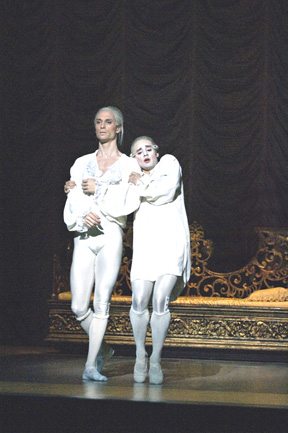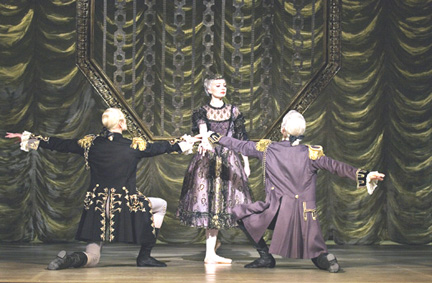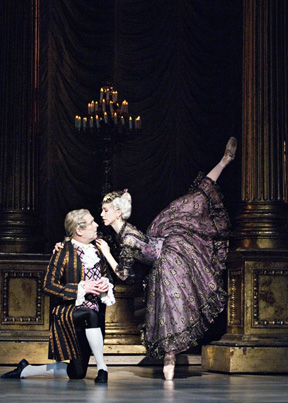Kings and Queens
"Caroline Mathilde"
Royal Danish Ballet
The Opera House
Copenhagen, Denmark
February 2007
copyright ©2007, Eva Kistrup
 Thomas Lund, Gudrun Bojesen. Mads Blangstrup. Silja Schandorff. Four of the most outstanding representatives of the celebrated Danish ballet tradition. Elegant dancers. Great actors. Great stage power. Enormous range. In short, a quartet of dancers who can carry full responsibility for a ballet and who can enhance a ballet with qualities beyond the choreographer's visions and limitations. And never have I witnessed one evening in my experience with the Royal Danish Ballet where those particular skills of the dancers worked so much magic on a very bad ballet.
Thomas Lund, Gudrun Bojesen. Mads Blangstrup. Silja Schandorff. Four of the most outstanding representatives of the celebrated Danish ballet tradition. Elegant dancers. Great actors. Great stage power. Enormous range. In short, a quartet of dancers who can carry full responsibility for a ballet and who can enhance a ballet with qualities beyond the choreographer's visions and limitations. And never have I witnessed one evening in my experience with the Royal Danish Ballet where those particular skills of the dancers worked so much magic on a very bad ballet.
On paper and in still photos, Flemming Flindt's "Caroline Mathilde' looks like a sure winner. Set in the beautiful rococo scenery and costumes by the late Jens Jacob Woorsaa, Flindt's ballet tries to tell the sad and romantic tale of the young English princess Caroline Mathilde (Gudrun Bojesen), a sister to George III who was shipped to Denmark to marry the young— and unfortunately stark mad—king Christian VII. (Thomas Lund). As the king descended into greater madness, his power was ursurped by his advisor and doctor Struenss (Mads Blangstrup), who also became the lover of the young queen and fathered her second child. A counter coup was staged by the king's evil stepmother, Juliane Marie (Silja Schandorff). Struensee was decapitated and Caroline Mathilde sent into exile; she died within a few years.
 It sounds like Kenneth MacMillan's "Manon" meets "Mayerling," but unfortunately Flindt cannot make a coherent ballet out of the material. Instead we get a long list of scenes with little point and he borrows heavily from not only Cullberg and Petit, whom he has always copied, but also from John Neumeier. Unfortunately it is not what could be learned from John Neumeier that he borrows but the jester trio, the interpolated play in the play, and the coming-to-the-ball scene from "Romeo and Juliet." Flindt has great difficulties in remembering who is his designated principal character, and instead keeps on adding scenes with the mad, but entertaining, king.
It sounds like Kenneth MacMillan's "Manon" meets "Mayerling," but unfortunately Flindt cannot make a coherent ballet out of the material. Instead we get a long list of scenes with little point and he borrows heavily from not only Cullberg and Petit, whom he has always copied, but also from John Neumeier. Unfortunately it is not what could be learned from John Neumeier that he borrows but the jester trio, the interpolated play in the play, and the coming-to-the-ball scene from "Romeo and Juliet." Flindt has great difficulties in remembering who is his designated principal character, and instead keeps on adding scenes with the mad, but entertaining, king.
Thomas Lund danced the king some 13 years ago as a very young dancer, and it showed then what an original dramatic artist he is. This time around he was even better and he especially managed to get the clumsy choreography to look good and poignant. It is a strange paradox that one of our most stylish dancers has such a knack for making Flindt's choreography work. It was the same in "The Lesson" a few months back, and it is almost reason enough to keep Flindt's ballets in repertoire, as they offer Thomas Lund large, interesting parts.
 Gudrun Bojesen is likewise very convincing as Caroline Mathilde, and develops the timid girl into a great romantic heroine; her pas de deux with Mads Blangstrup's symphatic and striking Struensee become the dancing highlight of the evening. Silja Schandorff has no problem whatsoever in nailing the ice queen stepmum and powerhouse Juliane Marie. The quartet managed to raise the quality of the work to a level it ca not maintain on its own, and that unfortunately became clear when second cast got their shot.
Gudrun Bojesen is likewise very convincing as Caroline Mathilde, and develops the timid girl into a great romantic heroine; her pas de deux with Mads Blangstrup's symphatic and striking Struensee become the dancing highlight of the evening. Silja Schandorff has no problem whatsoever in nailing the ice queen stepmum and powerhouse Juliane Marie. The quartet managed to raise the quality of the work to a level it ca not maintain on its own, and that unfortunately became clear when second cast got their shot.
Izabela Sokolowska (Caroline Mathilde), Morten Eggert (Christian VII) , Andrew Bowman (Struensee) and Caroline Cavallo (Juliane Marie) are all very competent dancers, but they lack the magical skills of the first quartet, and although they can dance a ballet well and show it as it is, they ca not make it better, and therefore the evening seemed long and dull and "Caroline Mathilde' was shown to be as pointless a ballet as it is.
 Unfortunately, these performances shows that although Frank Andersen's vision for the Royal Danish Ballet to be the leading dramatic ballet company in the world is a great vision, it has a serious downside in the fact that there are not that many great dramatic ballets available, at least, not in the recent back catalogue of the company. But how about looking back a bit longer and revive for instance "Carmen" and "Miss Julie," which was very successful in the 50s and 60s? We got a segment from "Carmen" at a gala a few years back with Silja Schandorff and Kenneth Greve and they were terrific. And how about reviewing a few of the Tetley ballets like "Firebird" and "Voluntaries" which were so successful in the 80s? How about another MacMillan or Cranko ballet? One cannot help feeling that the decision to revive "Caroline Mathilde" had more to do with the fact that it was available and relatively cheap rather than on its artistic merit. Surely not only the audience could remember what a disappointment it was — and unfortunately still is, save n the strong hands of real kings and queens.
Unfortunately, these performances shows that although Frank Andersen's vision for the Royal Danish Ballet to be the leading dramatic ballet company in the world is a great vision, it has a serious downside in the fact that there are not that many great dramatic ballets available, at least, not in the recent back catalogue of the company. But how about looking back a bit longer and revive for instance "Carmen" and "Miss Julie," which was very successful in the 50s and 60s? We got a segment from "Carmen" at a gala a few years back with Silja Schandorff and Kenneth Greve and they were terrific. And how about reviewing a few of the Tetley ballets like "Firebird" and "Voluntaries" which were so successful in the 80s? How about another MacMillan or Cranko ballet? One cannot help feeling that the decision to revive "Caroline Mathilde" had more to do with the fact that it was available and relatively cheap rather than on its artistic merit. Surely not only the audience could remember what a disappointment it was — and unfortunately still is, save n the strong hands of real kings and queens.
Photos by Henrik Stenberg
Volume 5, No. 9
March 5, 2007
copyright ©2007 by Eva Kistrup
www.danceviewtimes.com